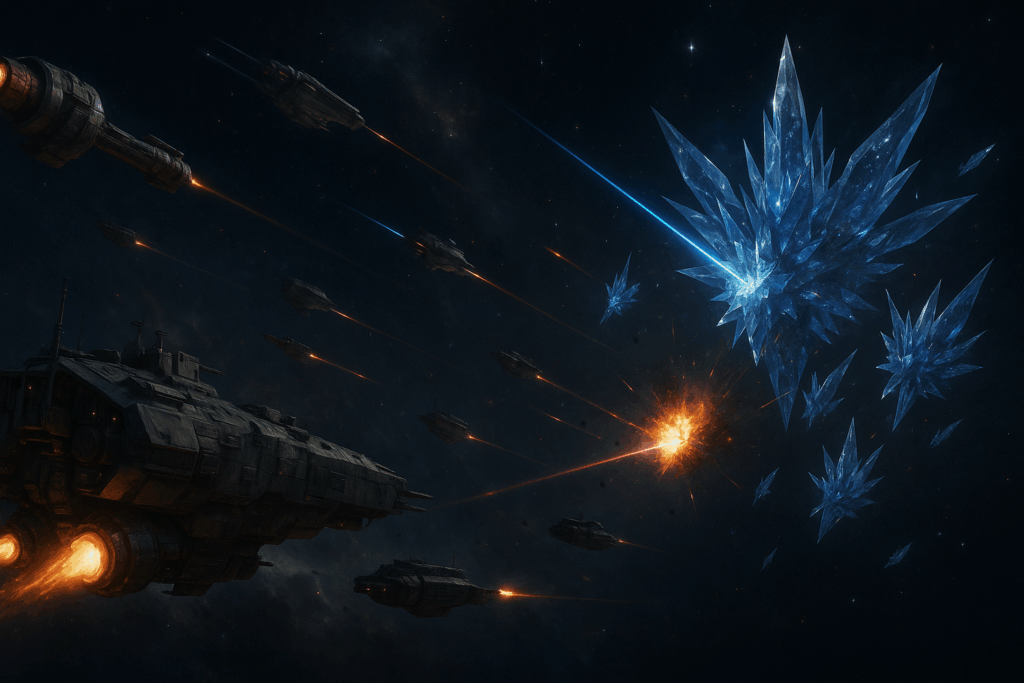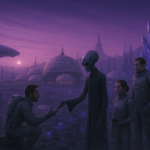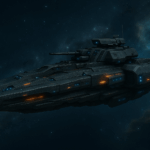The Terran-Kytherian War had raged for fifteen years, transforming from a border skirmish into a galaxy-spanning conflict that consumed entire star systems. What began as a dispute over mining rights in the Proxima Centauri sector had escalated when the Kytherians—a technologically superior species with crystalline exoskeletons and hive-mind tactical coordination—declared humanity an “inferior biological anomaly” that needed correction.
The war’s tide had turned decisively against Earth. Kytherian fleets, with their quantum-entangled communication networks and adaptive shield matrices, had systematically dismantled human defensive lines. Their ships moved with eerie synchronization, each vessel acting as a node in a vast computational network that could predict and counter human tactics before they were even fully implemented.
By 2387, the Human Defense Force had been pushed back to a handful of core worlds. The once-mighty fleets that had carried humanity to the stars now existed as scattered remnants, desperately trying to buy time for civilian evacuations. It was in this context of inevitable defeat that Admiral Helena Torres found herself commanding Task Force Lazarus—a collection of obsolete vessels that should have been decommissioned decades ago.
The Stranding
The Indomitable, Torres’s flagship, shuddered as another Kytherian plasma lance carved through its already-compromised armor plating. Around her, the bridge crew worked with the desperate efficiency of people who knew they were fighting a losing battle. The ship’s AI, designated “Muse,” had been installed when Torres was still a lieutenant—an ancient system by current standards, but one she trusted more than the newer, supposedly superior models.
“Admiral, the quantum tunnel is destabilizing!” Lieutenant Mark “Sparky” Evans called out from his position at the tactical console. His nickname came from his uncanny ability to coax performance from failing systems, often accompanied by literal sparks and the smell of burning circuits. “We’ve got maybe thirty seconds before it collapses completely!”
Torres gripped her command chair as another impact sent tremors through the ship’s superstructure. Through the viewscreen, she could see the swirling vortex of the artificial wormhole they’d been using to retreat from the Kytherian advance. Behind them, enemy vessels closed in like metallic predators, their hulls gleaming with an otherworldly luminescence.
“All ships, emergency jump! Now!” Torres commanded.
The fleet—if it could still be called that—consisted of seven vessels: the heavy cruiser Indomitable, two destroyers (Defiant and Resolute), three frigates (Courage, Tenacity, and Hope), and the supply ship Providence. Each ship bore the scars of countless engagements, their hulls patched with whatever materials could be found, their weapon systems jury-rigged and held together by determination and engineering tape.
As the ships plunged into the quantum tunnel, Kytherian fire followed them. The tunnel’s walls, already unstable from the enemy’s exotic weapons, began to collapse. Space-time folded in on itself with a violence that made reality scream.
When the chaos subsided, Task Force Lazarus found itself in an unfamiliar star system, their quantum drives burned out and their navigation systems showing impossible readings. They were deep in Kytherian space—farther behind enemy lines than any human force had ever ventured.
“Muse, give me a tactical assessment,” Torres said, her voice steady despite the gravity of their situation.
The AI’s response came in its characteristic measured tones, tinged with what almost sounded like dry humor. “Admiral, we are approximately 847 light-years behind enemy lines, in what appears to be the Kytherian Hegemony’s primary industrial sector. Our quantum drives are inoperative, conventional FTL will take approximately 23 years to reach friendly space, and we are surrounded by an estimated 200 enemy installations.”
Sparky let out a low whistle. “Well, that’s just fantastic. We’re like a mouse that wandered into a snake convention.”
Torres studied the tactical display, her mind already working through possibilities. The Kytherians would expect them to surrender—it was the logical choice. Their species valued efficiency above all else, and continuing to fight in such circumstances would seem like pointless waste to them.
Which was exactly why they wouldn’t see what was coming.
The Ghost Fleet Awakens
The first Kytherian patrol found them three days later. A squadron of six sleek interceptors, their crystalline hulls refracting starlight into prismatic displays of beauty and menace. The patrol leader’s transmission was broadcast on all frequencies, its tone carrying the mechanical precision typical of their species.
“Human vessels, you are in violation of Hegemony space. Surrender immediately for processing and integration into the collective efficiency matrix.”
Torres smiled grimly. “Sparky, are the modifications ready?”
“As ready as they’ll ever be, Admiral. Though I should mention that what we’re about to do violates about seventeen different safety protocols.”
“Noted. Muse, initiate Protocol Anachronism.”
What happened next would have been impossible with modern human ships. The newer vessels relied on quantum-encrypted communication networks, adaptive AI systems, and predictive tactical algorithms—all of which the Kytherians had learned to counter. But Task Force Lazarus operated on principles that predated the war by decades.
The Indomitable suddenly went dark, its energy signature vanishing from Kytherian sensors. This wasn’t stealth technology—it was simply the ship shutting down every non-essential system, including the advanced sensors that the enemy had learned to track. The other ships followed suit, becoming invisible not through sophisticated cloaking but through the simple expedient of becoming indistinguishable from space debris.
The Kytherian patrol, confused by the sudden disappearance of their targets, began standard search patterns. They were still following their algorithms when the human ships struck.
The attack came from multiple vectors simultaneously, but not in any pattern the Kytherians recognized. Instead of the coordinated, networked assault they expected, each human ship acted independently, using tactics that seemed almost random. The Defiant came in high, firing kinetic rounds—actual metal projectiles that the Kytherian shields weren’t calibrated to stop. The Resolute attacked from below, using mining charges as improvised torpedoes.
Most shocking of all was the Indomitable‘s approach. Instead of maintaining safe distance and relying on long-range weapons, Torres brought her ship in close—dangerously close—and opened fire with point-defense guns that hadn’t been used in ship-to-ship combat for over a century.
The Kytherian interceptors, their tactical networks overwhelmed by the sheer unpredictability of the assault, were destroyed in less than four minutes. Not a single human ship took significant damage.
“Well,” Sparky said, watching the debris field expand on his screen, “that was either brilliant or completely insane.”
“Why not both?” Torres replied. “Muse, analysis?”
“The enemy’s tactical algorithms appear to be optimized for countering modern human warfare doctrine. Our obsolete systems and improvised tactics fall outside their predictive parameters, creating significant tactical advantages.”
Torres nodded. She was beginning to see the shape of a strategy—one that would have been impossible with a modern fleet, but might just work with their collection of antiques and misfits.
The Doctrine of Chaos
Over the following weeks, Task Force Lazarus became a ghost haunting the Kytherian supply lines. They struck without warning, using tactics that seemed to follow no discernible pattern. Sometimes they attacked in formation, sometimes individually. They used everything from conventional weapons to improvised explosives made from mining equipment.
The key to their success lay in their very obsolescence. The Kytherians had spent years studying human tactical doctrine, developing countermeasures for every strategy in the Human Defense Force playbook. But Torres wasn’t using the playbook—she was making it up as she went along, drawing on half-remembered lessons from military history and the desperate improvisations of a crew that had nothing left to lose.
Sparky proved invaluable in these engagements, his talent for jury-rigging systems allowing them to deploy weapons and tactics that shouldn’t have been possible. He turned mining lasers into ship-killers, rigged cargo containers as decoy vessels, and somehow managed to make their ancient point-defense systems more effective than modern plasma cannons.
Muse, despite being an obsolete AI by current standards, became their secret weapon. Unlike the newer systems that relied on quantum processing and predictive algorithms, Muse operated on older principles—pattern recognition, adaptive learning, and what could only be described as intuition. The AI began to develop an almost supernatural ability to anticipate Kytherian movements, not through calculation but through something approaching instinct.
“Admiral,” Muse reported during one engagement, “I am detecting what appears to be frustration in the enemy communication patterns.”
Torres raised an eyebrow. “Frustration? They’re a hive mind, Muse. They don’t do emotions.”
“Nevertheless, their tactical responses are becoming increasingly erratic. They appear to be… improvising.”
This was unprecedented. The Kytherians were known for their cold efficiency, their ability to adapt and counter any threat through collective intelligence. But Task Force Lazarus was presenting them with something they had never encountered: pure, unpredictable chaos.
The human fleet’s reputation began to spread through Kytherian space. They called it the “Ghost Fleet”—a collection of primitive vessels that appeared without warning, struck with impossible effectiveness, and vanished before reinforcements could arrive. Some Kytherian commanders began to report that their tactical networks were developing what could only be described as anxiety subroutines when operating in sectors where the Ghost Fleet had been sighted.
The Impossible Victory
The decisive moment came when Task Force Lazarus encountered the Kytherian Third Battle Group—a massive formation of over forty vessels, including three dreadnoughts and a command carrier. It was a force that could have single-handedly conquered most human colonies, and it was bearing down on their position with the clear intent of ending the Ghost Fleet’s reign of terror once and for all.
“Admiral,” Sparky said, his voice tight with tension, “we’re looking at odds of roughly six to one. And that’s not counting the fact that their smallest ship outguns our largest.”
Torres studied the tactical display, her mind racing through possibilities. Conventional wisdom said they should run—try to escape and continue their hit-and-run campaign elsewhere. But something in the enemy formation caught her attention.
“Muse, analyze their approach vector. What do you see?”
The AI paused for a moment—an eternity in computer terms. “They are approaching in perfect formation, Admiral. Textbook Kytherian battle doctrine. Each ship positioned for optimal mutual support and fire coordination.”
“Exactly. They’re fighting the war they know how to fight. Sparky, how much mining explosive do we have left?”
“About three tons of industrial charges, plus whatever we can jury-rig from the Providence‘s cargo. Why do I get the feeling you’re about to suggest something that violates the laws of physics, common sense, and probably several treaties?”
Torres smiled. “Because you know me too well. Here’s what we’re going to do…”
What followed was less a battle than a masterpiece of controlled chaos. Instead of engaging the Kytherian formation directly, Torres ordered her ships to scatter—not in retreat, but in a seemingly random pattern that made no tactical sense. The enemy, expecting either a coordinated defense or an organized withdrawal, found themselves facing something unprecedented: seven ships moving independently, each following its own agenda.
The Courage and Tenacity began laying mines in seemingly random patterns, using their entire stock of mining charges. The Hope started broadcasting false sensor readings, creating the illusion of additional ships where none existed. The destroyers Defiant and Resolute began a series of hit-and-run attacks that seemed designed more to annoy than to inflict serious damage.
Meanwhile, the Indomitable and Providence began what appeared to be a desperate retreat toward the system’s asteroid belt. The Kytherian commander, recognizing an opportunity to end the engagement quickly, ordered a pursuit.
It was exactly what Torres had hoped for.
The asteroid field had been seeded with mining charges—not in any organized pattern, but scattered seemingly at random throughout the debris. When the Kytherian ships entered the field in pursuit formation, Sparky triggered the charges in a sequence that defied all logic.
The explosions didn’t target the enemy ships directly. Instead, they shattered asteroids, sending massive chunks of rock careening through space in unpredictable trajectories. The Kytherian formation, designed for mutual support in open space, became a liability as ships found themselves dodging debris while trying to maintain their tactical network.
In the chaos that followed, Task Force Lazarus struck with everything they had. But instead of coordinated attacks, each ship acted independently, striking targets of opportunity as they presented themselves. The Defiant rammed a damaged Kytherian cruiser, its captain having calculated that the ship was too damaged to survive anyway. The Resolute used its mining lasers to cut through the command carrier’s hull, targeting not weapons or engines but the quantum communication arrays that coordinated the enemy fleet.
The battle lasted six hours and defied every principle of modern space combat. When it was over, the Kytherian Third Battle Group had been completely destroyed, while Task Force Lazarus had lost only the Defiant—and even then, most of her crew had been evacuated before the ramming attack.
The Long Road Home
News of the impossible victory spread through both human and Kytherian space like wildfire. For humanity, it was the first major victory in years—proof that the war was not yet lost. For the Kytherians, it was something far more disturbing: evidence that their perfect tactical algorithms could be defeated by something as simple as unpredictability.
The psychological impact was enormous. Kytherian fleets began to hesitate, their commanders second-guessing their tactical networks. Human resistance movements, inspired by the Ghost Fleet’s example, began adopting similar tactics—abandoning sophisticated strategies in favor of improvised chaos.
But for Torres and her crew, the victory was bittersweet. They were still trapped deep in enemy space, their ships held together by determination and engineering tape. The quantum drives remained inoperative, and conventional FTL would take decades to reach friendly space.
It was Muse who provided the solution, in a moment of inspiration that surprised even the AI itself.
“Admiral, I have been analyzing the wreckage of the Kytherian command carrier. Their quantum communication system operates on principles similar to our tunnel drives. With sufficient modifications, we might be able to create a stable wormhole.”
Sparky looked up from his console, where he had been trying to repair a burned-out power coupling with spare parts and hope. “Let me guess—this plan involves doing something that’s theoretically impossible with equipment that shouldn’t work?”
“Naturally,” Torres replied. “Muse, what do you need?”
The modifications took three weeks and required cannibalizing systems from every ship in the fleet. The Providence was stripped down to little more than a hull, its cargo holds converted into a massive quantum resonance chamber. The other ships provided power, their reactors linked in a configuration that made Sparky mutter prayers to various engineering deities.
When they finally activated the system, the results were spectacular. A wormhole opened—not the stable, predictable tunnel of modern technology, but a chaotic, roiling vortex that seemed to exist in defiance of several fundamental laws of physics.
“Well,” Torres said, watching the impossible sight on her viewscreen, “it’s not pretty, but it should get us home.”
Heroes’ Return
Task Force Lazarus emerged from the wormhole in the Sol system six months after they had been presumed lost. Their arrival was detected by defense platforms that initially classified them as unknown contacts—their ships were so heavily modified and battle-damaged that they barely registered as human vessels.
The fleet that limped toward Earth bore little resemblance to the force that had departed. The ships were scarred, patched, and held together by improvised repairs. But they flew in formation, their crews proud and unbroken.
The reception was unlike anything in human history. Every ship in the system—military and civilian alike—formed an honor guard as Task Force Lazarus made its way to Earth. The crews were hailed as heroes, their tactics studied and adopted by military academies across human space.
But perhaps the most significant impact was psychological. The Ghost Fleet had proven that humanity’s greatest strength wasn’t its technology or its tactics—it was its ability to adapt, to improvise, to find solutions where none should exist. In a war against an enemy that valued efficiency and predictability above all else, chaos had become humanity’s greatest weapon.
Torres stood on the bridge of the Indomitable as Earth grew larger on the viewscreen. Beside her, Sparky was already planning modifications to the ship’s systems, while Muse processed the flood of communication requests from military commanders eager to learn their secrets.
“Admiral,” Muse said, “I have been analyzing our mission parameters. By all logical calculations, we should not have survived.”
Torres smiled. “That’s the thing about humans, Muse. We specialize in doing things that shouldn’t be possible.”
As Task Force Lazarus entered Earth orbit, the war was far from over. But something fundamental had changed. The Kytherians, for all their technological superiority, had learned to fear the unpredictable chaos of human ingenuity. And in the depths of space, other obsolete fleets began to adopt the tactics of the Ghost Fleet, turning the galaxy into a battlefield where the impossible happened on a daily basis.
The age of predictable warfare was over. The age of beautiful chaos had begun.


